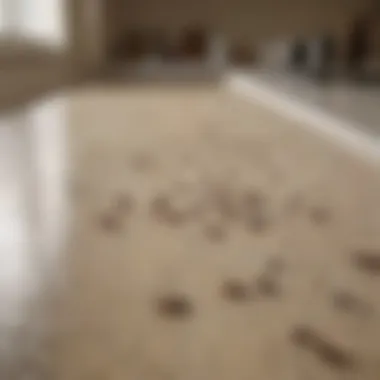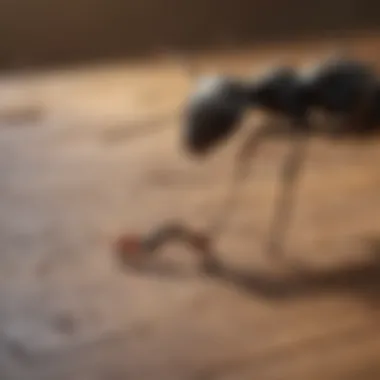Natural Methods for Effective Ant Removal


Intro
Entering a home can bring many comforts, but it also can invite unwanted guests like ants. Understanding ants and their behavior is crucial for effective removal and prevention. This article focuses on what homeowners can do to handle ant infestations using natural methods. With a clear focus on sustainability, we explore various eco-friendly approaches while ensuring health safety for all residents.
Identification of Common Pests
Description of Common Pests
Ants belong to a diverse family of insects, with species like the Argentine ant, carpenter ant, and odorous house ant frequently making appearances in homes. The Argentine ant is particularly notorious for its aggressive foraging and quick reproduction. In contrast, carpenter ants can cause structural damage when they tunnel into wood. Odorous house ants emit a distinct smell when crushed, a feature that can help in identifying them.
Signs of Infestation
Detecting ant presence early is vital.
- Foraging Ants: Seeing ants traveling in a line is a clear sign of foraging. They may be looking for food.
- Nesting Sites: Check for ant nests near foundations, under rocks, or within wooden structures.
- Ant Trails: Ants leave pheromone trails leading back to their nests. Following these trails can help determine their source.
Knowing these signs helps in promptly identifying ant issues before they escalate.
Prevention Techniques
Home Maintenance Tips
Maintaining a clean environment is essential in prevention. Here are some straightforward tips to consider:
- Seal Entry Points: Use caulk to seal cracks and holes in walls and foundations.
- Store Food Properly: Keep food in airtight containers to avoid enticing ants.
- Regular Cleaning: Sweep floors and wipe surfaces to eliminate crumbs and spills that attract ants.
Environmental Modifications
Making alterations to the surroundings can deter ants. Some effective strategies include:
- Trim Vegetation: Ensure plants and trees are trimmed to prevent ants from using them as bridges into homes.
- Manage Mulch: Use mulch sparingly as it can create nesting opportunities for ants.
Implementing these changes can reduce the likelihood of an infestation.
Eco-Friendly Pest Control Options
Natural Pesticides
Using non-toxic materials is key. Some natural solutions include:
- Diatomaceous Earth: This powder, made from fossilized algae, can effectively kill ants when they walk over it.
- Essential Oils: Peppermint and tea tree oil have shown effectiveness in repelling ants. Mixed with water, they make a potent spray.
Organic Pest Control Techniques
Beyond pesticides, other methods can be employed:
- Boric Acid: A small amount can be mixed with sugar. This technique attracts ants for consumption, effectively leading to their demise.
- Vinegar Solution: Mixing vinegar and water can disrupt the scent trails ants use to navigate.
Remember: While these natural alternatives are effective, persistence and consistency are essential in dealing with ant problems.
Understanding Ant Behavior
Understanding ant behavior is crucial for effectively managing ant infestations in residential spaces. It provides insight into how ants operate, which can be key to utilizing natural removal methods. By recognizing their patterns, habits, and preferences, homeowners can tailor their approaches to ensure a more efficient resolution.
Ants exhibit complex social structures. They work together to gather food, build nests, and care for their young. This cooperative nature means that where there is one ant, there are likely many more nearby. Understanding these dynamics helps individuals appreciate the scale of an infestation and the potential for re-infestation if not fully addressed.
Moreover, insights into ant behavior can assist in identifying the most effective natural remedies. Different species may respond to varying solutions; therefore, knowing which type of ant is present can significantly influence the outcome.


In summary, knowledge of ant behavior not only informs effective treatment options but also aids in prevention strategies. It allows homeowners to act more strategically, leading to lasting solutions rather than temporary fixes.
Common Species of Ants
In residential areas, several ant species are frequently encountered. Knowing these species can aid in identifying and addressing infestations more effectively.
- Carpenter Ants: These ants are known for hollowing out wood to create their nests. They are generally larger and black or bicolored.
- Argentine Ants: Small and light in color, these ants form massive colonies and are often a nuisance in kitchens.
- Pavement Ants: Typically found under sidewalks, these ants are small and dark brown.
Familiarizing oneself with the common types of ants can direct homeowners toward more effective natural remedies specific to the species.
Ant Communication Methods
Ants communicate primarily through chemical signals called pheromones. This form of communication is vital for their survival and the organization of their colonies. When an ant finds food, it releases pheromones to alert others, creating a path for the colony.
The ability of ants to communicate helps them coordinate activities such as foraging and defense. Understanding these methods can not only clarify why certain areas attract more ants but also assist in devising strategies to disrupt their trails.
Nesting Habits of Ants
Ants can establish their nests in various places, such as underground, inside wooden structures, or in wall voids. Recognizing where these nests are commonly found can be beneficial in addressing infestations.
- Underground Nests: Often found in gardens or lawns, these nests can be expansive, with networks of tunnels.
- Wooden Nests: Carpenter ants often nest in damp or decaying wood, making them more problematic for homes.
- Indoor Nests: Some species may nest in walls or other hidden areas, which complicates removal.
Understanding the nesting habits of ants allows homeowners to focus their removal efforts more strategically. This knowledge is especially helpful for applying natural solutions effectively.
Identifying Ant Infestations
Understanding how to identify ant infestations is crucial for effective pest management in residential settings. Different species of ants exhibit various behaviors and nesting habits, making early identification essential in determining the appropriate response. Early detection not only minimizes damage but also prevents a small problem from escalating into a larger infestation.
Identifying an ant issue involves recognizing the signs of ant activity and determining the specific type of ant responsible. Knowing what to look for can help homeowners address the problem promptly and efficiently. In addition, understanding the species can guide the selection of suitable natural removal methods tailored to that particular ant type. Here are two essential subtopics to consider:
Signs of Ant Activity
To effectively identify an ant infestation, it is necessary to look for various signs indicating their presence.
- Trail Marks: Ants communicate through pheromones, leaving a scented trail as they move. This trail can often lead you to their nesting sites.
- Nesting Sites: Observe around your home for small mounds of soil or debris. These could indicate where ants are nesting.
- Food Disruptions: An increase in food debris or marks on food containers can signify ant activity.
- Visible Ants: Spotting individual ants, especially during their foraging activities, is a clear indicator they are around.
Homeowners should be vigilant, especially in warm months when ant activity increases.
Determining the Type of Ant
Once signs of activity are evident, determining the type of ant involved becomes important for targeted management. Different species may require distinct approaches due to their varying behaviors and feeding patterns.
- Carpenter Ants: These ants can be identified by their larger size and preference for wood. Look for wood shavings or hollow-sounding wood.
- Sugar Ants: Typically attracted to sweet substances, sugar ants are often found in kitchens or areas with food waste. They are smaller and darker in color.
- Fire Ants: Fire ants are aggressive, and their stings can cause irritation. They build noticeable mounds outdoors.
Identifying the species can be complex, but it often falls under examining physical characteristics or behavior patterns. For more specific guidance, resources such as Wikipedia or Britannica may provide valuable insights. Understanding these distinctions plays a critical role in effectively managing ant populations in your home.
Impacts of Ants in the Home
Understanding the effects related to ant infestations in residential areas is critical for homeowners. Ants are more than just nuisance pests; their presence can lead to various health risks and potential structural issues. Recognizing these impacts can assist in taking timely and appropriate action, making it an essential topic in this discourse.
Food Contamination Risks
Ants often invade kitchens and food storage places in search of sustenance. Their behavior raises concern over food contamination. When ants forage for food, they can travel over unsanitary surfaces, picking up germs and bacteria that can be transferred to food items. The potential risk for foodborne illnesses increases significantly in households with active ant problems. For instance, the common house ant has been tied to the spread of pathogens that can have adverse health effects on humans.
To mitigate these risks:
- Ensure all food is stored in sealed containers.
- Clean up spills and crumbs promptly.
- Use planning to set traps and eliminate access points for ants. This proactive approach can minimize the likelihood of contamination.
Implementing these practices can help maintain a healthier living environment and prevent serious repercussions.


Structural Concerns
In addition to health risks, ants can pose threats to the structural integrity of homes. Some species, such as carpenter ants, are notorious for their ability to damage wooden structures. They do not consume the wood, but instead excavate it to create nests, leading to significant damage over time. This tunneling can weaken beams, causing issues that may require costly repairs.
Homeowners should be vigilant for signs of wood damage, including:
- Hollow-sounding wood when tapped.
- Sawdust piles near wooden structures.
- Visible ant trails leading to wood sources.
Addressing these issues early is vital. If structural damage is suspected, consulting with a professional pest control expert or a structural engineer can help determine the extent of the damage and appropriate remedial actions.
"Understanding the risks associated with ant infestations is essential for preventing long-term harm to both health and property."
In essence, the impact of ants extends beyond being mere irritants. Being informed about food contamination risks and structural concerns allows homeowners to take actionable steps, ensuring a safer and healthier home environment.
Natural Remedies for Ant Removal
Natural remedies for ant removal hold significant importance in maintaining a healthy home environment. Homeowners increasingly seek more eco-friendly options to combat pest issues without prompt reliance on harsh chemicals. Natural solutions can minimize risks to both health and the ecosystem while effectively managing ant populations. Understanding these remedies can empower individuals to take charge of their homes and employ strategies that are safe for their families and pets.
Vinegar Solutions
Vinegar is a well-known household staple that can assist in ant removal. It contains acetic acid, which disrupts the scent trails ants use for navigation. To create an effective solution, mix equal parts of water and vinegar in a spray bottle.
Spray this mixture in areas where you notice ant activity. The strong odor will deter ants, effectively breaking their path. The only downside is that the strong scent may persist for a short while. Reapplication might be necessary, especially after rain or cleaning.
Essential Oils
Essential oils provide potent ant deterrents due to their aromatic compounds. Clove, peppermint, tea tree, and lemon oils are particularly effective. Mixing these oils with water creates a natural repellant. A common ratio is around 10–15 drops of essential oil per cup of water.
When sprayed around entry points and on ant trails, these oils interfere with ant sensory organs, making areas less inviting. These oils not only repel ants but also leave a pleasant scent in the home. As with other remedies, regular application may be needed.
Diatomaceous Earth
Diatomaceous earth is a natural powder composed of crushed fossilized algae. It works by damaging the exoskeleton of ants upon contact, eventually leading to dehydration and death. It is safe for pets and humans, provided you use food-grade diatomaceous earth.
To apply, sprinkle a thin layer in areas where ants are active. Avoid overdoing it, as excessive application can reduce its effectiveness. This method is best used in combination with other natural techniques for greater efficacy.
Boric Acid Baits
Boric acid can be effective and safe when applied correctly. It acts as a slow-acting poison for ants, which allows them to return to the colony and share the bait with others. A mixture of boric acid, sugar, and water creates a bait that attracts the ants due to its sweetness while delivering a lethal dose.
To prepare, dissolve one cup of water, one cup of sugar, and a couple of teaspoons of boric acid. Soak cotton balls in this mixture and place them in shallow containers. Ensure they are out of reach from children and pets. Regular checking and replenishment will ensure ongoing effectiveness.
Natural Deterrents
Several common household items serve as natural deterrents against ants. Items like coffee grounds, cinnamon, and black pepper can disrupt an ant's navigation and deter them from entering specific areas. Placing these around entry points or paths may help keep ants at bay.
In addition, vinegar and water solutions or essential oils can supplement these deterrents to create a multifaceted approach. Keeping the environment clean, filling in cracks, and employing these natural remedies can work together for effective pest control.
"Natural remedies present sustainable options for ant management, focusing on long-term solutions that are kind to the planet."
Preventing Future Infestations
Preventing future ant infestations is crucial for maintaining a harmonious home environment. Ants can appear in various species, each with different behaviors and nesting habits. This section focuses on effective strategies that homeowners can use to minimize the risk of ant invasions. The benefits of prevention lie not just in avoiding the nuisance of pests, but also in protecting one's health and property.
Sealing Entry Points
One of the first steps in ant prevention is identifying and sealing entry points around the house. Ants are small and can easily squeeze through tiny cracks and gaps. Common entry points include:


- Doors and windows: Ensure that screens are intact and seal cracks around frames with caulk.
- Utility entrances: Check where pipes and wires enter the home; use expanding foam to fill any gaps.
- Foundations: Inspect the foundation for cracks or openings where ants can enter. Repairing these areas can significantly reduce ant entry.
Sealing entry points acts as the first line of defense against ant infestations.
By taking these measures, homeowners can create a more substantial barrier against these pests, reducing the likelihood of an infestation before it even begins.
Maintaining Clean Spaces
Cleanliness plays a vital role in preventing ant infestations. Ants are often attracted to food sources, so maintaining a clean environment reduces these attractions. Here are some practical tips to maintain a clean living space:
- Regularly sweep and vacuum: This helps remove food particles that might attract ants.
- Dispose of trash properly: Ensure garbage cans are tightly sealed and emptied regularly.
- Wipe surfaces: Clean countertops, tables, and floors daily to remove spilled food and sugary residues.
Taking proactive steps to keep spaces clean not only deters ants but can also improve the overall hygiene of the home.
Proper Food Storage
Proper food storage is another crucial aspect of ant prevention. Ants are drawn to food sources, particularly sweets and oils. Here are ways to secure food storage effectively:
- Use airtight containers: Store food items in sealed containers, especially sugary products. Glass or hard plastic containers are best.
- Refrigerate perishable items: Items like fruits and leftovers should be stored in the refrigerator to prevent attracting ants.
- Manage pet food: If you have pets, do not leave their food out all day. Store pet food in airtight containers, and clean up spills quickly.
By implementing these food storage techniques, homeowners can significantly lower the chances of ants finding a food source that leads to potential infestations.
When to Seek Professional Help
In some cases, homeowners may need to consider professional assistance in dealing with ant infestations. While natural methods are often effective, certain situations require expert intervention. Recognizing these scenarios can save time and further complications. Understanding when to seek help ensures that the ant issue is managed effectively without endangering health or property.
Recognizing Severe Infestations
It’s crucial to identify the signs of a severe ant infestation. An infestation can develop rapidly if not addressed in the early stages. Homeowners should be vigilant for multiple indications:
- Large Trails: Ants often create visible trails when foraging for food. Large groups moving persistently indicate a significant presence.
- Nesting Sites: If nests are found inside the home, this is a clear sign of a serious problem. Ants may nest in walls, kitchens, or basements.
- Frequent Sightings: Seeing ants daily, particularly in various locations, suggests that the infestation is extensive.
Beyond just the frequency of sightings, homeowners need to be mindful of specific ant species present. Some ants, like carpenter ants, can cause structural damage. In these cases, immediate action is necessary to prevent property damage.
"Recognizing the signs of an infestation is the first step toward effective pest management."
If an infestation persists despite natural removal methods, it indicates that professional help is warranted. An expert can provide tailored solutions that address the specific species and the extent of the infestation.
Choosing a Pest Control Expert
When selecting a pest control expert, it’s important to consider multiple factors. Not all professionals offer the same services, and understanding what to look for can lead to better outcomes. Here are key considerations while choosing:
- Credentials and Experience: Ensure the expert has relevant qualifications. Certification and years of experience in pest control can indicate proficiency.
- Eco-Friendly Options: Look for a pest control expert who uses environmentally friendly methods. This aligns with the desire for sustainable pest control solutions.
- Reviews and References: Check for testimonials or reviews online. This can provide insights into the expert's success rate and customer satisfaction.
- Detailed Consultation: A good professional should offer a thorough analysis of the situation. They should explain their approach and answer any questions, ensuring the homeowner feels informed.
Culmination
Summary of Natural Techniques
Natural methods are not only effective in removing ants but also promote a healthier living space. Some notable techniques include:
- Vinegar solutions: A mixture of water and vinegar can disrupt ant trails, preventing them from returning.
- Essential oils: Oils such as peppermint and tea tree can repel ants due to their strong scents.
- Diatomaceous earth: This natural powder can dehydrate ants upon contact, effectively eliminating them.
- Boric acid baits: When used correctly, boric acid acts as a slow poison, targeting the entire colony.
- Natural deterrents: Ingredients like cinnamon or citrus peels are often effective in keeping ants at bay.
Each of these remedies harnesses common household items, making them accessible and easy to implement. Using these techniques can create a less hospitable environment for ants, thereby reducing their presence in the home.
Long-term Management Strategies
Maintaining a home free of ants requires consistent effort and strategic planning. Homeowners can benefit from adopting proactive long-term management strategies, such as:
- Sealing entry points: Inspecting the exterior of the home and sealing cracks and gaps can prevent ants from gaining access.
- Maintaining clean spaces: Regular cleaning, particularly in kitchens, minimizes food sources that attract ants. Wipe down surfaces and store food properly.
- Proper food storage: Using airtight containers for food can limit accessibility for ants.
By combining these strategies with natural removal methods, homeowners can achieve lasting results against ant infestations.
Evaluating the various approaches and implementing them judiciously can lead to a more comfortable living space free from the nuisance of ants.
Equipped with this knowledge, readers can take informed actions to manage ant problems effectively and sustainably.







